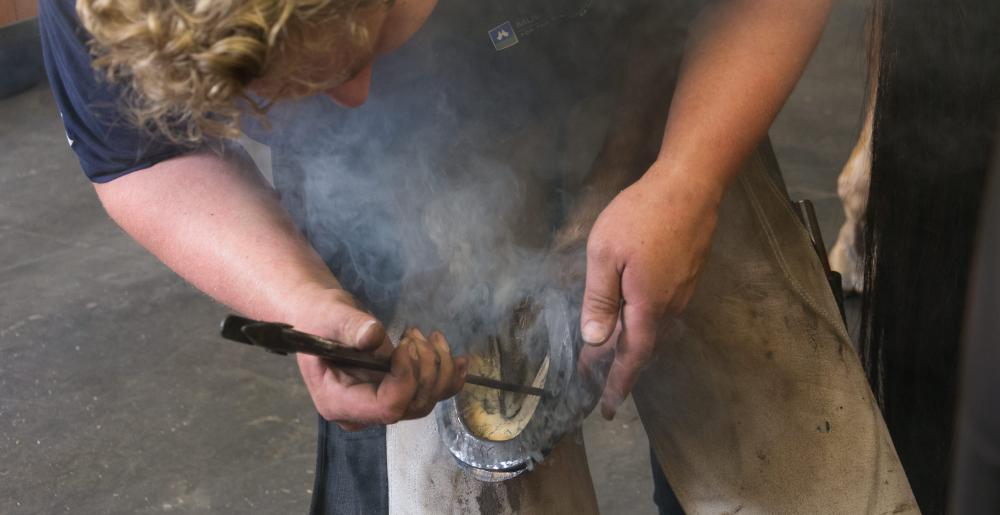Old family business, modern vision
Christoph Schweppe, Master farrier and teacher in Germany

The farriery of the Schweppe family is located near one of the access roads to the German city of Dortmund. They started here in 1850, when a horse and carriage were the main means of transport. Christoph Schweppe – 5th generation – now runs the business. His father is retired, but still around, blacksmithing custom products such as fences and metal art.

In 2001, at the age of 19, Christoph started 3 years of education and apprenticeship. In 2006 he became a Master farrier in Leipzig.
He specializes in jumping, dressage and orthopaedics and has a farrier school. As of 2018, this school will also give Master training in a course spread over the entire year.
The well-being of the horses and the service for my clients comes first
Christoph met his wife Diana during their studies. She is a farrier as well, but now mainly does the administration. Carsten Fährmann is the other farrier in the company. They always have apprentices. Clients either come to the farriery or are visited on location. The company has its own horses for training and stables and grounds for horses that need a longer term orthopaedic treatment.
For Christoph, the service and the well-being of his horses comes first. That sometimes leads to funny situations. ‘I once was called by a client whose warmblood Merry had a cracked hoof. When I asked how big the crack was, the client said 10cm. This was an emergency!
I dropped my work, cancelled all other appointments and drove to the customer right away. When arriving at the scene, it appeared that the customer was too much in panic when she called. She had made a small mistake: centimeters turned out to be millimeters…”

Schweppe joins in international contests and he is ambitious to reach a higher level. Initially he competed together with Grant Moon as a partner and he trains with him a couple of times per year. He is often impressed by the high quality of the English contest farriers and he notices that France is getting better and better in the international field.
I'm ambitious in competitions, I want to reach a higher level
Christoph doesn’t only use pre-fabricated shoes; he always forges aluminium shoes himself and in exceptional cases, also steel shoes.
“My favourite shoe type is the LiBero, because I can make anything out of it.” He mostly uses E-slim and MX nails. These models give the best results for the type of terrains that Schweppe’s horses walk on. The shape of their heads and their exact fitting prevents very fine sand from entering the nail hole and causing extra wear. This prevents a premature loosening of the shoe.
His most important tips for a starting farrier are:
- “when starting with a new horse, pay good attention to its entire posture, let it move freely and move with a rider.”
- “the best for your customers and their horses is when you plan the next visit yourself, on average with an interval of about 5 to 7 weeks”
- for contest horses: “make an agenda with the rider or caretaker for the coming year. This will prevent you from getting into conflict with the contest schedule.”
- “try to work as thoroughly as possible”

Innovation is welcome, new products are mostly tested, but a new product has to match up with the company’s work, for example plastic shoes: most types cannot be used for jumping horses.
“One of the latest innovations that makes me happy is the new BaseMax shoe. Now that the clips have been set back, it makes it the best alternative in that segment. And its average quality is very high!”
The world is becoming smaller, regional differences in farriery will almost disappear
“I notice that the industry is changing. The internet has made the world smaller and young farriers now have a far better understanding of the English language. In the past, farriery was led by local traditions. Nowadays, the approach and methods are more and more driven by international visions and developments.” Christoph believes that this will lead to a global standard.
He believes in the power of sharing knowledge. In the end, all parties will benefit.
Christoph regularly gives advices to other farriers and – of course - former students. He likes the ease of sharing videos. Occasionally, when he needs to know how to forge a specific type of shoe in a contest, he looks at them himself.
He thinks it is good: “You always have to see further than the end of your nose”.
